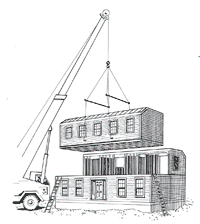
The last module of a two-story home being set on the foundation. |
A 1brief summary of Chapter 1 "Why Build Modular?" (18 pages) in The Modular Home, by Andrew Gianino, President of The Home Store Modular houses are built out of boxes, called modules, which are constructed off site, transported to a building lot, and assembled into a finished home. All of the materials - from framing, roofing, and plumbing to cabinetry, interior finish, and electrical - are identical to what you would find in a conventional "stick-built" home. The most striking thing about a modular home is not anything you can see, nor how it is made, but where it is made: in a modern factory designed to build good-quality modular homes.
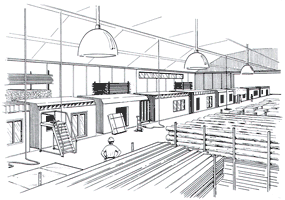
On the modular factory's assembly line, materials are organized for greatest efficiency and quality control. |
The modular factory system combines engineering know-how and factory-production methods to design and build more efficiently and with greater quality control. When done well, the efficiency results in lower costs and the quality control results in a better product. The idea of building homes, especially the components that make up a home, in a factory is not a recent phenomenon. Prefabricated houses have been built in the United States since the 1890s. Americans began buying houses out of mail-order catalogs as soon as it was possible to ship the materials cross-country by railroad. Sears sold about 100,000 mail-order homes from 1908 to 1940. The use of production-line techniques again picked up after World War II and made a sizable contribution to reducing the housing shortage that developed after the war. Even stick-built houses today use a growing number of mass-produced, factory-built components, including pre-hung windows and doors, roof trusses, interior moldings, drywall, and kitchen and bath cabinets. More and more aspects of home construction are being completed in factories because the factory environment helps to organize the construction process. By using automatic assembly equipment and repetitive assembly-line techniques, factories assemble component parts more efficiently and with greater consistency in product quality. This is true whether the components are assembled to make a window or an entire house. Virtually all of the best products in the world, from computers and appliances to automobiles and planes, are manufactured in factories. That is why both consumers and industry professionals in Japan and Scandinavia consider the modular method of home building superior to site-built construction. This makes it ironic that the country that has led the world in the design and mass production of manufactured goods, the United States, took until the 1980s to embrace prefabricated houses. Today, there is still a bit of a romantic notion that building custom home floor plans on site piece-by-piece is somehow superior. This belief lingers even though consumers would reject new appliances and automobiles that were built in someone's backyard, with the materials exposed to the weather and with no one watching over the assembly. Yet the romance with custom stick construction is starting to lose some of its bloom. Many stick builders have converted to modular houses, driven in part by the severe shortage of skilled construction workers. This shortage is being caused by older, experienced workers retiring or choosing less physically demanding work and by younger people choosing other careers. In an ABC News study of 10,000 high-school students that rated their interest in potential careers, the construction trades ranked 251st, right behind cowboy. In addition, those that are entering the trades are doing so with little formal training or mentoring. The problem is particularly severe in some trades, such as carpentry, where few companies have apprenticeship programs. A study by the National Association of Home Builders, which is made up primarily of stick builders, found that two of three builders are now forced to hire workers with skill levels below those expected for their jobs. This labor shortage has eroded craftsmanship, driven up prices, and caused delays, shoddy construction, and unhappy homeowners. Frustrated by these problems, custom stick builders have turned to modular homes as a way to introduce some control into the building process. Modular manufacturers have, in turn, enticed them by presenting new house plans that meet the needs of builders' style-conscious customers. Consumers in search of a custom-built home are also giving modular home designs a more favorable look. Sometimes they turn to modular houses because they cannot get a stick builder to respond in a timely fashion. More frequently, superior quality, faster completion time, and better prices are the primary inducements, along with greater energy efficiency, extended warranties, and flexible design options. Customers who want high-quality finishes as well as high-quality construction increasingly understand that they can get both with a modular home. Many consumers assume that the primary advantage of modular technology is lower prices. That is only the third most important reason for building a modular home. Faster construction time is the second, and superior quality is the first. 
To learn why each of the following contributes to the better quality that is the hallmark of a modular home, see chapter 2, "Why Build Modular?" (18 pages) in The Modular Home (325 pages) by Andrew Gianino:
-
Trained and closely supervised workforce
-
Larger, more powerful, and more sophisticated equipment
-
Assembly with precision jigs
-
Use of the highest quality, kiln-dried lumber
-
Construction in a climate controlled facility with materials protected from the elements
-
Construction standards that meet or exceed local and state building codes
-
Unparalleled structural strength
-
Superior energy efficiency
-
Rigorous quality control systems
-
Extended warranty coverage
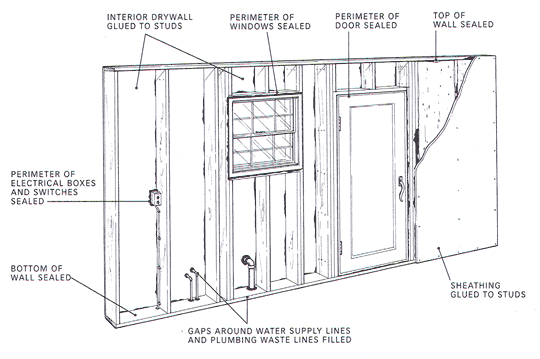
Standard modular construction practices, such as sealing air penetrations around electrical outlets and plumbing pipes, make a modular home more energy efficient than a typical stick-framed home. |
Building a modular home will normally save you time compared with building a conventional stick-framed house. Saving time on construction not only saves money, it also reduces the stress involved in home building. The faster you build your home, the sooner you will be able to enjoy it and dispense with the worries and preoccupations of construction. When a manufacturer is building without a production backlog, it delivers a house five weeks after the customer has finalized the plans and obtained a building permit and financing. The general contractor begins the site work and completes the foundation while the manufacturer is building the house. If the house is small, uncomplicated, requires little on-site construction, and the GC is not too busy, it will be completed in about three weeks. Adding these two time frames together, a prospective homeowner can plan to move into the house eight weeks after finalizing the preliminary steps. In most regions of the country, the fastest stick builders require at least 13 weeks to build a small, uncomplicated custom house, and many need several weeks longer. Even the most efficient stick builder is significantly limited by small subcontractor crews. His systems are no match for the modular manufacturer's assembly line and large workforce. Consequently, the simplest stick-built house completed by the most competent custom builder is likely to take at least five weeks longer than a comparable modular home. A typical two-story house that includes a garage, porch, and deck will take a few weeks longer for both the modular builder and the stick builder. Larger, more complicated modular home designs, such as a 7,500-square-foot two-story, will take considerably longer to build. If the design requires substantial custom finish work and multiple site-built structures, and the GC has a substantial backlog, it might take sixteen weeks or longer to complete the home after it is set on the foundation. Adding the five weeks required by the manufacturer to build and deliver the house produces a total of 21 weeks. A good custom stick builder is likely to take at least a couple of months longer to complete such a project, since he will have considerably more work to do from scratch compared to the modular builder, who will have most of the house built at the factory. Manufacturers of prefab homes are usually able to build new house plans more affordably than custom stick builders, for the same kinds of reasons that automobile manufacturers are able to build a new car for far less than a mechanic could build the same car in his garage. They include:
-
Volume purchases of materials, which allows modular manufacturers to secure significant discounts
-
Lower labor costs: Experienced factory workers are well paid, with good benefits, but they do not command the wages paid to professional carpenters, plumbers, electricians, and painters
-
Assembly-line efficiencies: Organizing the construction process with inventory controls, power tools and equipment, and quality-control systems enables the factory crews to produce a home with greater efficiency than a handful of construction workers building in the field
-
Less material loss: Inclement weather does not damage the materials
-
Less pilferage and vandalism: Factories are easier to secure than building sites
-
Less waste: By working with standardized dimensions, modular manufacturers are better able to make optimal use of materials and avoid waste
To compare the costs of modular home designs versus site building, you need to make sure you are comparing apples with apples. For a modular house, add the dealer's price for the house to the general contractor's price for finishing the new house plans at the site. In an area with average construction-labor costs, you can expect to save about 5 percent over a comparable site-built house for the part of the house built by the manufacturer and GC. You will not save any money on the other construction work, however, since the GC will charge the same amount to clear the land, drill the well, install a septic system, install a driveway, build a foundation, and a landscape the property, regardless of the type of house being built. He will also charge the same for building a garage, deck, porch and other site-built structures. The construction costs for prefabricated houses are always fixed in advance of construction. Most modular dealers and manufacturers offer guaranteed prices for long periods of time, even in a market of moderately rising material and labor costs. To secure this price lock, the customer needs to authorize their home to be built, sign-off on all plans and specifications, and have their order accepted by the manufacturer. This process greatly reduces the possibility of cost miscalculations and overruns later. Many site builders have a price-escalation clause in their contracts that remains in force until the house is finished. In a typical construction season, prices are unlikely to rise by more than a few percent. But every few years there are some dramatic price increases, usually caused by sudden spikes in demand due to natural disasters or building booms. If material prices were to rise sharply during construction of a stick-built home, the customer might be responsible for a big jump in costs. Many customers save even more money on the construction financing of their modular homes than they save purchasing it. The significantly shorter construction phase required to build a modular home means there are fewer monthly interest payments required to service the loan. Lenders like modular home designs because customers are unlikely to incur large cost overruns, the home will be built on schedule, and the quality is predictable. The construction inspections are also easier to complete for a lender, since a modular home is mostly built at the time of the first inspection. The shorter construction period lessens your exposure to the typical risks that attend construction sites, such as vandalism and the pilferage of construction materials. Vandalism is further curtailed because the modules can be secured more rapidly than a site-built home. The ability to quickly secure the modules also makes it more difficult for someone to steal construction materials. Pilferage is further reduced because of the size of the modules; you cannot walk off with a module in the way you can carry away a few sticks of lumber. And completing the home more quickly reduces your biggest financial risk, that of a personal injury to a contractor working on the job or a neighborhood child playing around the home after hours. 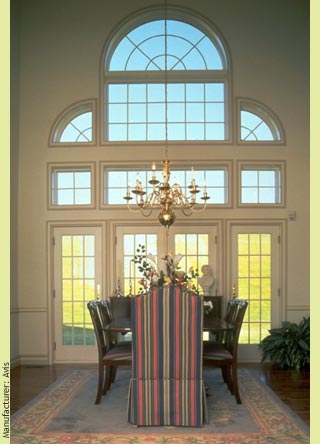
A sublime Palladian window frames this dining room
Building a modular home compels the customer and the dealer to complete most, if not all, of the planning steps before beginning construction. That is because the manufacturer cannot begin construction without knowing what it is going to build and how much it is going to charge. This forces the customer and dealer to make final decisions about the home's design and its building specifications. Some customers building a custom stick home complete their planning tasks with the help of an architect, others with the help of a builder. But it is much easier to skip some of these steps when stick building, since to some extent customers and builders can make things up as they go along. These planning steps sometimes get short shrift when stick building because it takes a large investment of time on the part of both the customer and the builder, just as it does when building a modular home. When pressed for time, both parties often prefer to start construction and postpone the meetings and decisions to a later date. Modular dealers would be just as prone to do this if they could get away with it. The planning discipline imposed by modular construction is an advantage for customers, because as most banks will tell you, poor planning almost always leads to cost overruns. For example, customers who do not spend enough time thinking through the design of their home often discover some design flaws once construction has started. One week they notice that the foyer closet is too small, the next week they decide that it is better to make the dining room smaller so the kitchen can be larger, and the following week they realize that the door to the study will be swinging into a bookcase. When they make discoveries like this, they have the choice of accepting the layout as is or asking the builder to make the necessary changes, which might include tearing down the walls he has already built. If they decide to make the changes, all of the additional costs are passed on to the customer through expensive change orders. Another way in which delayed planning can cost a customer money is when "allowances" are used to cover the cost of materials that have not yet been selected, such as cabinets and flooring. This is sometimes done so that construction can be started before every selection has been made. The builder assigns a dollar amount for those items yet to be specified. The allowances are adjusted, often higher, depending on the cost of the customer's final decisions. If you build a modular home, you and your dealer will not have many opportunities to procrastinate on your decisions, and you will not be subject to as many unbudgeted expenses. Many people want to build their own home but are afraid of getting in over their head. This book does not encourage you to take the do-it-yourself route. In fact, it strongly recommends hiring a professional GC with modular experience. If you are going to take the leap, however, modular construction is a much better way to act as your own GC while building your first home than stick building, primarily because there is less work to do and it is more defined and manageable. Also, if you want to complete some of the construction tasks yourself, you are less likely to be overwhelmed by the work because the tasks are more limited in scope. This book will not turn amateur home builders into modular professionals, but it will help you make the right decisions and stay on budget and on schedule. 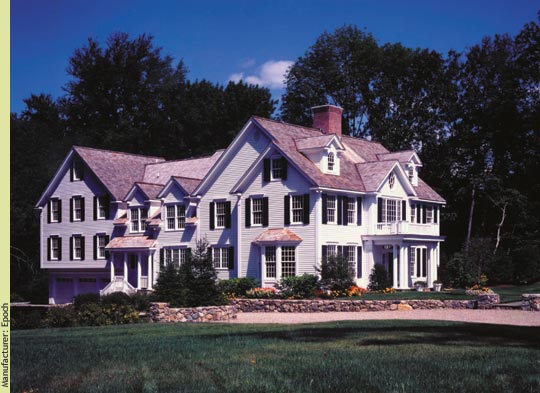
Each wing is large enough to be a home on its own
In the late 1970s, modular homes had the reputation of being affordable, as long as you were satisfied with mediocre finish quality and limited design choices. Today, modular homes are still affordable, but with first-rate quality and a wide selection of creative designs. Modern assembly lines are producing unique, custom designs that were not possible a few years ago. All manufacturers have an array of standard plans that are traditional in function and style. Many modular manufacturers supplement their standard offerings with more modern modular homes and designs that could pass for a contemporary architect's creation. Many of them, in fact, have been created by architects, as that profession has begun to explore the possibilities of modular design. Manufacturers have learned to use wood and steel beams to open up floor plans, and they have borrowed from both classical and contemporary elevations to give their homes attractive exteriors. Steeply pitched roofs, vaulted and cathedral ceilings, reversed gables, and angle bay towers are just a few of the design elements that grace modular homes today. When complex house plans cannot be built completely at the factory, a few of the cutting-edge manufacturers build as much of the house as possible at the factory, with the rest to be completed on site by the GC. Many manufacturers are willing to help everyone design a plan that expresses their personal preferences. You may start with one of their standard plans or a design of your own - wheelchair accessible floor plans, luxury fixtures, and other factory-built features. Computer-aided design (CAD) has made it possible to prepare custom home floor plans quickly and accurately. As long as it can be built economically in their factory, most manufacturers will consider building it. The design work begins with the dealer, but the modular manufacturer completes the engineering when it prepares production plans, which detail the actual construction of a house. The combined design and engineering services provided by the dealer and the manufacturer are substantially greater than what is provided by custom site-builders, who are usually small and without the necessary time and resources. Most dealers and manufacturers charge very reasonable fees for their services. When a customer needs detailed design assistance to construct a site-built home, he often must obtain it from an architect, who rightfully will charge thousands of dollars for the work. Manufacturers routinely customize a home's interiors as well as exteriors according to a customer's tastes. Skylights, central vacuum cleaners, whirlpool tubs, and bay and bow windows are just as common in modular homes as in site-built homes. Hardwood floors, solid-surface countertops, and cedar siding can be installed either at the factory or on site. After a home is set on the foundation, the GC can customize it with a porch, balcony, deck, sunroom, or garage. In short, modular homes can be every bit as luxurious as stick-built homes. Modular construction has become the construction method of choice for the quality- and cost-conscious house buyer. The best-built modular homes are better built than the vast majority of stick-built homes. Modular homes offer better materials, state-of-the-art construction technology, superior finished quality, and time and money savings. And you gain all of these benefits without sacrificing design or amenities. Chapter Index To learn more about building a modular home, read excerpts from the other chapters of The Modular Home, (325 pages) by Andrew Gianino, President of The Home Store:
Chapter 1: Why Build Modular
Chapter 2: Selecting a Dealer
Chapter 3: Designing a Home
Chapter 4: Specifications and Features
Chapter 5: Selecting a General Contractor
Chapter 6: Finding and Preparing a Building Lot
Chapter 7: The General Contractor's Responsibilities
Chapter 8: Building a Modular Addition
Chapter 9: Financing a Modular Home
Chapter 10: Warranty Service
Chapter 11: Building on Schedule
To purchase a complete copy of The Modular Home, click here.
|

